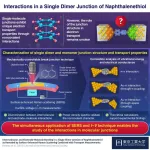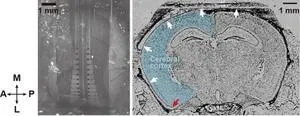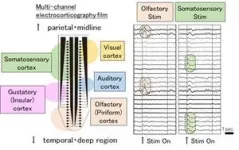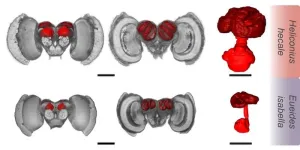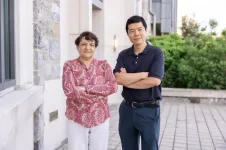(Press-News.org) The structure of a molecular junction with noncovalent interaction plays a key role in electron transport, reveals a recent study conducted by researchers at Tokyo Tech. Through simultaneous surface-enhanced Raman scattering and current–voltage measurements, they found that a single dimer junction of naphthalenethiol molecule shows three different bondings, namely π–π intermolecular and through-π and through-space molecule–electrode interactions.
The π–π interaction is a type of noncovalent interaction that occurs when the electron clouds in the π orbitals of aromatic rings or π-conjugated molecular systems overlap. This interaction enables an efficient movement of electrons between the molecules, offering the potential to design materials with unique electronic properties. The structure of the junctions formed by these molecules plays a decisive role in electron transport. However, insufficient structural information on these junctions has made it challenging to establish a clear relationship between the structure and electron transport properties.
To address this knowledge gap, a group of researchers from Japan, led by Assistant Professor Satoshi Kaneko and Associate Professor Tomoaki Nishino from Tokyo Institute of Technology (Tokyo Tech), has recently fabricated a single dimer and monomer junction of naphthalenethiol (NT) molecule and conducted a detailed examination of their structure and electron transport properties using combined optical and electrical measurements. Their study was published recently in the Journal of the American Chemical Society.
The researchers fabricated the junction by first depositing a gold electrode on a phosphor bronze plate coated with a polyimide layer. Next, they selectively removed the polyimide material beneath the central region of the gold electrode, forming a free-standing structure. Finally, they added ethanol solution containing NT dropwise on to the substrate, resulting in the formation of a single layer of NT molecules linking the gold electrodes.
Having fabricated the junction, the researchers then conducted simultaneous in situ surface-enhanced Raman scattering (SERS) and current–voltage measurements (I–V) by employing the mechanically-controllable break-junction technique. “This was followed by a correlation analysis of the measured vibrational energy and electrical conductance values, enabling the identification of the intermolecular and molecule–electrode interactions and transport properties in the NT junction,” explains Dr. Kaneko.
The current–voltage measurements revealed distinct high-conductivity and low-conductivity states. While a high-conductance state originated from an NT–monomer junction, where the molecule interacts directly with gold electrodes through direct π-bonding, the low-conductance state emerged due to an NT dimer formed by intermolecular π–π interaction.
However, considering vibrational energy alongside conductance confirmed three distinct structures at the junction, corresponding to a high-conductance state and two low-conductance states, respectively. When the naphthalene ring—in both dimer and monomer configurations—directly interacted with the gold electrodes through π coupling, highly conductive junctions were formed. Conversely, weak interactions between the naphthalene ring and the gold electrode through space coupling resulted in weakly conductive junctions.
“The simultaneous application of SERS and I-V technique could discriminate the various noncovalent interactions in the NT molecular junction, shedding light on its electron transport properties. In addition, the noncovalent character was also revealed by the power density spectra,” highlights Dr. Nishino.
The present findings thus provide important insights into π–π interactions that could pave the way for utilizing aromatic molecules in the design of future electronic devices and technologies.
###
Nishino Lab.
Visualizing Temperature Transport: An Unexpected Technique for Nanoscale Characterization | Tokyo Tech News
Towards Self-Restoring Electronic Devices with Long DNA Molecules | Tokyo Tech News
How small can they get? Polymers may be the key to single-molecule electronic devices | Tokyo Tech News
About Tokyo Institute of Technology
Tokyo Tech stands at the forefront of research and higher education as the leading university for science and technology in Japan. Tokyo Tech researchers excel in fields ranging from materials science to biology, computer science, and physics. Founded in 1881, Tokyo Tech hosts over 10,000 undergraduate and graduate students per year, who develop into scientific leaders and some of the most sought-after engineers in industry. Embodying the Japanese philosophy of “monotsukuri,” meaning “technical ingenuity and innovation,” the Tokyo Tech community strives to contribute to society through high-impact research.
https://www.titech.ac.jp/english/
END
New research suggests that targeting autoimmune inflammation associated with amyotrophic lateral sclerosis (ALS) using two drugs, one of them already approved for multiple sclerosis, could be a promising approach for treatment.
ALS, also known as Lou Gehrig's disease, is a progressive neurodegenerative disease that affects the nerve cells in the brain and spinal cord. It leads to the gradual loss of muscle control, eventually resulting in paralysis and difficulty with speech, swallowing, and breathing. The exact cause of ALS is not fully understood, and currently, there is no cure ...
Taylor & Francis has taken a significant step in reducing unnecessary plastic use with the introduction of paperwrap for journal print copies mailed in the UK.
Paperwrap, a relatively new packaging technology, has become more common in recent years, but is typically most suited to publications with very high print runs. Taylor & Francis’ Global Supplier Team spent several months investigating how it might be applied to journal print runs, which included rolling out live trial mailings to colleagues around the world to test how the journals could be packaged, and whether there was any impact on the speed ...
A new talking therapy for depression has shown encouraging early signs of being more effective and cheaper to deliver than the current best practice of Cognitive Behavioural Therapy (CBT).
A pilot trial from the University of Exeter, funded by the National Institute of Health and Care Research (NIHR) and published in Lancet EClinical Medicine, has found Augmented Depression Therapy (ADepT) could be a significant advance in depression care.
A core feature of depression is anhedonia (reduced ...
A team of scientists led by CABI have conducted a new study which shows that three ways to fight the invasive Prosopis juliflora tree in Ethiopia, Kenya and Tanzania all proved very effective in almost all cases.
The three-year research, published in the journal CABI Agriculture and Bioscience, revealed that cut stump and basal bark herbicide application and manual uprooting were highly effective, killing the trees in between 85-100% of cases.
In addition, three incremental restoration interventions were tested ...
Laptops and schoolwork on kitchen tables, a deserted playground, face masks on a washing line, an empty church, a walk in the woods.
As the UK Covid inquiry continues for a fifth week, researchers at the University of East Anglia have created a unique snapshot of lockdown life.
When the pandemic first hit, the team embarked on a project to track the physical and mental health of the nation. More than a thousand participants signed up and up and they were followed every day for three months in the first study of its kind.
As well as keeping daily lifestyle diaries about their physical activity, diet and mood, ...
Heliconius butterflies’ brains grew as they adopted a novel foraging behaviour, scientists at the University of Bristol have found.
A region of their brain, known as the mushroom body due to its shape, are two to four times larger than those of their close relatives.
The findings, published today in Nature Communications, suggest that the structure and function of the nervous system are closely linked to an organism's ecological niche and behaviour.
Dr Stephen Montgomery of Bristol’s School of Biological Sciences explained: “Heliconius are the only butterflies known to collect and digest pollen, which gives them an adult source ...
New Haven, Conn. — While pembrolizumab is an approved treatment for patients with stage III non-small cell lung cancer (NSCLC), only some patients respond to this therapy. Treatment failure, researchers say, is often caused by differences in the tumor microenvironment. An ongoing phase II study (KEYNOTE-495/KeyImPaCT) led by a researcher at Yale Cancer Center reveals that combining pembrolizumab with other treatments reduced the size of target tumors, resulting in a higher response rate for patients with advanced NSCLC.
The new research was published July 10 in Nature Medicine.
“We are excited to share these new ...
Every night, uncounted numbers of devices across the globe update their operating systems (OS), and everyday users log on expecting fast, secure connections and services to keep their increasingly online lives moving forward. But as artificial intelligence and other more complex systems come online, the foundation of all them is teetering.
Every aspect of society — from government and industry to education and entertainment — relies on devices with stable operating systems. And every OS relies on ...
The National Science Foundation, the National Institutes of Health, and the National Aeronautics and Space Administration have collectively awarded millions of dollars in grant funding to numerous Virginia Tech researchers who all have one thing in common.
They were awarded Emerging Social Aspects of Global Change seed funding.
Since 2015, this funding has led to faculty from seven colleges and 15 departments collaborating and engaging in 10 research projects that address the social or policy aspects of major global environmental issues.
Sponsored by Fralin Life Sciences Institute’s Global Change Center and the Institute ...
Imagine you just swallowed a pill containing a miniature camera that will help your doctor collect images to diagnose a condition you’ve been battling for years. No, it’s not something from the latest science fiction or Marvel Comics movie – it’s a technique called bioimaging.
While traditional methods of bioimaging such as an MRI, CT scan, or an X-ray are more commonly known, the use of nanodevices is becoming more popular. They are less invasive and provide health care professionals with a closer look deep inside tissue.
Researchers from Virginia Tech’s College of Engineering and College of Science are using their expertise ...
